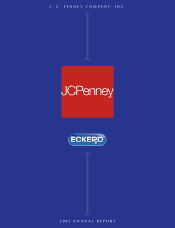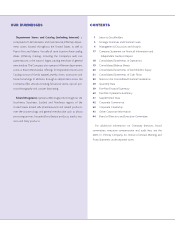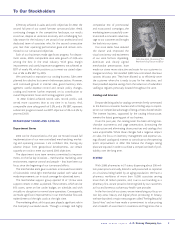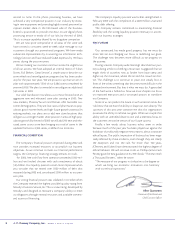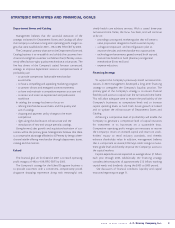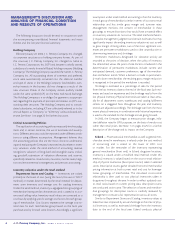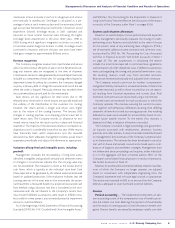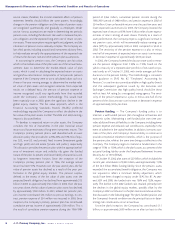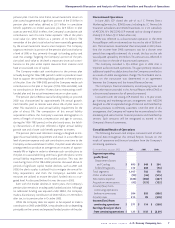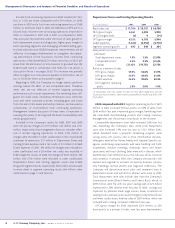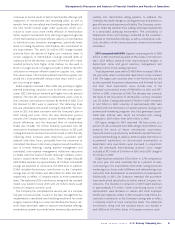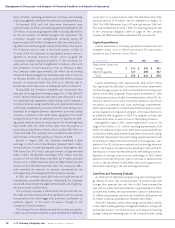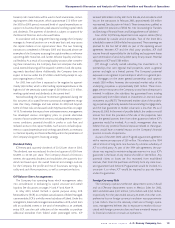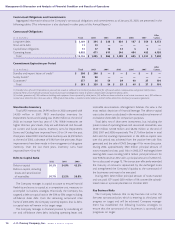JCPenney 2002 Annual Report Download - page 8
Download and view the complete annual report
Please find page 8 of the 2002 JCPenney annual report below. You can navigate through the pages in the report by either clicking on the pages listed below, or by using the keyword search tool below to find specific information within the annual report.
2002 annual report J. C. Penney Company, Inc. 5
Management’s Discussion and Analysis of Financial Condition and Results of Operations
inventories at least annually in each of its drugstores and at least
semi-annually in warehouses. Shrinkage is calculated as a per-
centage of sales at each inventory date and the estimated shrink-
age accrual rate between physical inventories is based on actual
experience. Eckerd’s shrinkage results in 2001 stabilized and
returned to more normal historical rates following the higher
shrinkage levels experienced in the prior three years, 1998 to
2000, during which significant integration activities occurred to
consolidate several drugstore formats. In 2002, shrinkage results
continued to improve, and over the past two years have bene-
fited gross margin by approximately 80 basis points.
Revenue recognition:
The Company recognizes revenue from merchandise and service
sales in its retail stores at the point of sale or service. Revenues for cat-
alog and internet sales are recognized at the time of shipment.
Commissions earned on sales generated by licensed departments are
included as a component of retail sales. For catalog orders shipped to
department stores for pickup by customers, the Company changed
its policy in January 2002 to charge the customer and record the sale
when the order is shipped. Previously, revenue was recorded when
the customer picked up and paid for the merchandise.
Sales returns are not significant for retail stores due to the
relatively short time frame in which returns are typically made and
the visibility of the merchandise to the customer. For catalog,
however, the return period is longer and return rates higher
due to the nature of the catalog business. The January 2002
changes in catalog payment and shipping policies have led to
lower return rates. The Company records an allowance for esti-
mated returns, based on the returns policy in place and historical
experience. The majority of the allowance relates to estimated cat-
alog returns and is considerably lower than last year. While returns
have historically been within expectations and the recorded
allowance has been adequate, management reviews actual return
experience periodically and adjusts the allowance, as appropriate.
Valuation of long-lived and intangible assets, including
goodwill:
Management evaluates the recoverability of long-lived assets,
identified intangibles and goodwill, annually and whenever events
or changes in circumstances indicate that the carrying value may
not be recoverable. The evaluation is done at the lowest level of
cash flows, which is typically at the individual store level. Cash
flows expected to be generated by the related assets are estimated
based on updated projections. If the evaluation indicates that the
carrying amount of the asset may not be recoverable, the poten-
tial impairment is measured based on a projected discounted cash
flow method using a discount rate that is considered to be com-
mensurate with the risk inherent in the Company’s current busi-
ness model. If different assumptions were made or different mar-
ket conditions were present, any estimated potential impairment
amounts could be different.
As of the beginning of 2002, Statement of Financial Accounting
Standards (SFAS) No. 142, “Goodwill and Other Intangible Assets,”
and SFAS No. 144, “Accounting for the Impairment or Disposal of
Long-Lived Assets,” became effective. See discussion of the impact
on results of the Company under Note 1 on pages 25-26.
Reserves and valuation allowances:
Based on an overall analysis of store performance and expected
trends, management periodically evaluates the closing of under-
performing stores. Reserves are established at the time of closure
for the present value of any remaining lease obligations (PVOL)
net of estimated sublease income, severance and other exit costs,
as prescribed by SFAS No. 146, “Accounting for Costs Associated
with Exit or Disposal Activities.” See further discussion in Note 1
on page 26. Two key assumptions in calculating the reserve
include the time frame expected to terminate lease agreements
and estimations of other related exit costs. If different assumptions
were used regarding the timing and potential termination costs,
the resulting reserves could vary from recorded amounts.
Reserves are reviewed periodically and adjusted when necessary.
The Company records a provision for workers’ compensation
and general liability risk based on actuarial estimates of claims that
have been reported, as well as those incurred but not yet report-
ed, resulting from historical experience and current data. Total
estimated claim amounts are discounted using a risk-free rate.
Income taxes are estimated for each jurisdiction in which the
Company operates. This involves assessing the current tax expo-
sure together with temporary differences resulting from differing
treatment of items for tax and accounting purposes. Any resulting
deferred tax assets are evaluated for recoverability based on esti-
mated future taxable income. To the extent that recovery is
deemed not likely, a valuation allowance is recorded.
The Company is involved in legal proceedings and governmen-
tal inquiries associated with employment, pharmacy business
practices and other matters. A reserve has been established based
on management’s best estimates of the Company’s potential liabil-
ity in these matters. This estimate has been developed in consulta-
tion with in-house and outside counsel and is based upon a com-
bination of litigation and settlement strategies. Management does
not believe that these proceedings and inquiries, either individual-
ly or in the aggregate, will have a material adverse effect on the
Company’s consolidated financial position or results of operations.
See further discussion in Note 19.
Reserves for potential environmental liabilities related to facilities,
most of which the Company no longer operates, are adjusted
based on consultation with independent engineering firms, the
Company’s experience and in-house legal counsel, as appropriate.
The reserve was increased in 2002 to an amount that the Company
believes is adequate to cover estimated potential liabilities.
Pension:
Pension accounting — The fundamental components of pen-
sion accounting consist of the compensation cost of benefits prom-
ised, the interest cost from deferring the payment of those benefits
and the results of investing assets to fund the pension benefit obli-
gation. Pension benefits are earned by employees ratably over their

